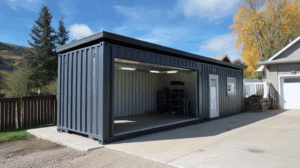Unlock the Potential: Converting Shipping Containers into Garages for Affordable and Stylish Storage
Are you in need of some extra storage space but don’t want to break the bank? Look no further than shipping containers! These versatile structures are not just for transporting goods across the seas anymore. With a little creativity and some DIY skills, you can easily convert a shipping container into a garage that is both affordable and stylish.
The Benefits of Shipping Container Garages
Cost-effective Solution
One of the main advantages of using shipping containers for storage is their affordability. Compared to traditional garage construction, which can be costly and time-consuming, converting a shipping container is a much more budget-friendly option. The price of a used container is significantly lower than building a garage from scratch, saving you money that can be put towards other projects or investments.
Quick and Easy Assembly
Another benefit of using shipping containers is their ease of assembly. Unlike traditional garage construction, which can take weeks or even months, converting a shipping container into a garage can be done in a matter of days. With a clear plan and some basic tools, you can transform a container into a functional storage space in no time.
Durability and Security
Shipping containers are built to withstand harsh conditions at sea, making them incredibly durable and secure. Made from high-quality steel, they are resistant to rust, pests, and extreme weather conditions. This means that your belongings will be safe and protected from the elements, giving you peace of mind.
Customizable and Versatile
One of the most exciting aspects of converting a shipping container into a garage is the endless possibilities for customization. With a little imagination, you can design a space that suits your specific storage needs and personal style. From adding windows and doors to insulation and electrical wiring, the options are limitless. You can also choose from a variety of exterior finishes, such as paint or cladding, to give your garage a unique and stylish look.
Tips for Converting a Shipping Container into a Garage
Plan Ahead
Before you start your conversion project, it’s essential to plan ahead. Take measurements of the area where you intend to place the container and consider any zoning or building regulations that may apply. Decide on the layout and features you want to incorporate, such as windows, doors, shelving, and lighting. Planning ahead will ensure a smooth and successful conversion process.
Insulation and Ventilation
To create a comfortable and usable space, it’s crucial to insulate your shipping container garage. Insulation will help regulate temperature, preventing extreme heat or cold from affecting your stored items. Additionally, proper ventilation is essential to prevent moisture buildup and maintain air quality. Consider installing vents or windows to allow for airflow.
Electrical Wiring
If you plan on using your shipping container garage for more than just storage, you’ll need to include electrical wiring. This will enable you to power lights, outlets, and other appliances or tools. Hiring a professional electrician is advisable to ensure all wiring is done safely and up to code.
Security Measures
While shipping containers offer inherent security, it’s always a good idea to take additional precautions to protect your belongings. Install sturdy locks on doors and windows to deter potential intruders. You can also consider installing a security system or surveillance cameras for added peace of mind.
Embrace the Possibilities
Converting a shipping container into a garage is an excellent way to unlock affordable and stylish storage space. With their cost-effectiveness, quick assembly, durability, and versatility, shipping containers offer a unique solution for your storage needs. So why not think outside the box and embrace the potential of shipping container garages? Let your creativity run wild and create a storage space that is both functional and visually appealing.
From Steel Box to Sleek Space: Converting a Shipping Container into Your Dream Garage
Are you tired of cluttered and cramped garage spaces? Do you dream of a sleek, modern, and functional garage that not only houses your vehicles but also serves as a multipurpose space for all your hobbies and storage needs? Look no further than a shipping container conversion!
Shipping container conversions have gained popularity in recent years, not only as affordable and sustainable housing solutions but also as versatile spaces for various purposes. With a little creativity and some DIY skills, you can transform a simple steel box into your dream garage, customized to meet your specific requirements.
The Advantages of a Shipping Container Garage
Converting a shipping container into a garage offers numerous advantages over traditional construction methods. Here are a few reasons why you should consider this unique approach:
1. Cost-Effective Solution
Building a traditional garage from scratch can be a costly endeavor. On the other hand, repurposing a shipping container as a garage can save you a significant amount of money. These containers are readily available at affordable prices, and the conversion process requires less labor and materials compared to conventional construction.
2. Quick and Easy Assembly
Shipping containers are designed to be transported and stacked efficiently. This means that they can be easily delivered to your location and assembled in a relatively short amount of time. With the right planning and preparation, you can have your dream garage up and running in no time.
3. Durability and Security
Made from weather-resistant steel, shipping containers are built to withstand harsh conditions during long-distance transportation. This inherent durability translates into a secure and robust structure for your garage. You can have peace of mind knowing that your vehicles and belongings are protected from the elements and potential intruders.
4. Customization Options
One of the most exciting aspects of converting a shipping container into a garage is the endless possibilities for customization. Whether you want to add windows for natural light, insulation for temperature control, or shelving for storage, you have the freedom to tailor your garage to suit your specific needs and style preferences.
Steps to Convert a Shipping Container into a Garage
Now that you’re convinced of the benefits, let’s explore the step-by-step process of converting a shipping container into your dream garage:
Step 1: Planning and Design
Before you dive into the conversion process, take some time to plan and design your garage. Consider factors such as the size of your vehicles, the number of parking spaces needed, and the additional features you want to incorporate. Sketch out a layout and create a list of materials and tools required for the project.
Step 2: Site Preparation
Prepare the location where the shipping container will be placed. Ensure that the ground is leveled and stable to provide a solid foundation. Depending on your local regulations, you may need permits or approvals for the installation of a shipping container on your property. Make sure to research and comply with any necessary requirements.
Step 3: Container Modification
Start by cleaning and inspecting the shipping container for any damages or rust. Repair and repaint the exterior as needed, using weather-resistant paint to enhance its longevity. Next, cut openings for doors, windows, and ventilation, based on your design plans. Install these features securely, ensuring proper sealing and insulation to maintain a comfortable environment inside the garage.
Step 4: Interior Design and Finishing Touches
Once the structural modifications are complete, it’s time to focus on the interior design of your dream garage. Install lighting fixtures for adequate illumination, lay down a durable and easy-to-clean flooring material, and consider adding storage solutions such as shelves, cabinets, and pegboards. Don’t forget to incorporate electrical outlets for powering tools and appliances.
Step 5: Security and Accessibility
To ensure the safety and security of your vehicles and belongings, it’s essential to implement proper security measures. Install sturdy locks on doors and windows, and consider adding an alarm system or surveillance cameras. Additionally, think about the accessibility of your garage. If you need to drive vehicles in and out, consider adding a ramp or a hydraulic lift for convenience.
Conclusion
Converting a shipping container into your dream garage is an innovative and cost-effective way to create a functional and stylish space for your vehicles and hobbies. With careful planning, creative design, and a little DIY spirit, you can transform a steel box into a sleek and personalized garage that meets all your needs. So, why settle for a conventional garage when you can have a one-of-a-kind shipping container conversion? Start envisioning your dream garage today!
Revolutionize Your Storage Solutions: How to Transform a Shipping Container into a Functional Garage
Are you tired of clutter and lack of space in your garage? Do you dream of having a functional and organized storage solution? Look no further than a shipping container! These versatile, sturdy, and cost-effective structures are not just for transporting goods across the globe anymore. With a little creativity and some DIY skills, you can easily transform a shipping container into a functional garage that meets all your storage needs. In this blog post, we will guide you through the process of revolutionizing your storage solutions by repurposing a shipping container into a highly practical and stylish garage.
Step 1: Choosing the Right Container
The first step in this transformative journey is selecting the right shipping container for your garage project. Shipping containers come in various sizes, including 20-foot and 40-foot options. Consider the available space in your yard or property and the items you plan to store. If you have limited space, a 20-foot container may be sufficient, while a 40-foot container offers more room for larger vehicles or additional storage space.
Ensure that the container you choose is in good condition, with minimal rust and structurally sound. Look for containers that have been retired from maritime use, as they tend to be more affordable and readily available.
Step 2: Preparing the Site
Before your shipping container garage can take shape, proper site preparation is essential. Clear the area where you plan to install the container, ensuring it is level and stable. Remove any obstructions such as rocks, debris, or tree roots that may hinder the placement of the container.
Step 3: Foundation and Anchoring
To ensure the stability and longevity of your shipping container garage, a solid foundation is crucial. Options for foundations include concrete slabs, gravel beds, or even wooden beams. Consult with a professional or do thorough research to determine the best foundation option for your specific needs and local building codes.
Anchoring the container to the foundation is vital for security, especially in areas prone to high winds or seismic activity. Use heavy-duty anchor bolts or twist-lock mechanisms to secure the container firmly to the foundation.
Step 4: Customization and Insulation
One of the advantages of repurposing a shipping container is the ability to customize it according to your requirements. Consider the layout of your garage and plan for the installation of doors, windows, and electrical outlets. Cut openings for these features using a grinder or plasma cutter, ensuring proper measurements and safety precautions.
To make your garage comfortable year-round, insulation is crucial. Shipping containers are made of steel, which can become extremely hot in the summer and cold in the winter. Apply insulation foam or fiberglass batts to the interior walls and ceiling to regulate the temperature inside your garage.
Step 5: Electrical and Plumbing
If you plan to use your shipping container garage as a workshop or for other purposes requiring electricity and plumbing, it’s essential to enlist the help of a qualified professional. Consult with an electrician and plumber to ensure all wiring, outlets, and plumbing connections are safely and correctly installed.
Step 6: Organization and Storage Solutions
Now that your shipping container garage is structurally complete, it’s time to focus on organization and storage solutions. Utilize the limited space efficiently by installing shelves, hooks, and pegboards. Consider using stackable storage bins, labeled containers, and wall-mounted tool holders to keep your items organized and easily accessible.
Step 7: Security and Safety Measures
To protect your valuable belongings and ensure the safety of your garage, consider incorporating security measures. Install sturdy locks on doors and windows, and consider adding security cameras or an alarm system. Adequate lighting, both inside and outside the container, is essential for visibility and safety during nighttime use.
Step 8: Exterior Finishing Touches
To enhance the aesthetic appeal of your shipping container garage, consider adding exterior finishing touches. Painting the container in a color that complements your property or adding siding can help it blend seamlessly with the surroundings. Landscaping around the garage can further enhance its appearance and make it a visually pleasing addition to your property.
Conclusion
By repurposing a shipping container, you can revolutionize your storage solutions and create a functional garage that meets all your needs. From choosing the right container to customizing it according to your requirements, this transformative project offers endless possibilities. Whether you need additional storage space, a workshop, or a place to keep your vehicles safe, a shipping container garage is an excellent option that combines affordability, durability, and style. So, roll up your sleeves, unleash your creativity, and embark on this exciting journey to transform a shipping container into a highly functional garage that will revolutionize your storage solutions for years to come.
Thinking Outside the Box: Creative Ideas for Converting Shipping Containers into Garages
When it comes to finding unique and innovative solutions for our living spaces, thinking outside the box has become the new norm. And one of the most exciting trends in the world of architecture and design is the conversion of shipping containers into functional and stylish living spaces.
But why limit the possibilities to just homes and offices? Shipping containers can also be transformed into fantastic garages that not only provide ample space for your vehicles but also add a touch of industrial chic to your property. In this blog post, we will explore some creative ideas for converting shipping containers into garages.
1. Single or Double Container Garage
The simplest and most straightforward way to convert a shipping container into a garage is to use a single container. With its sturdy structure and ample space, a single container can easily accommodate one vehicle while leaving enough room for storage or a small workshop area.
For those who require more space, a double container garage can be created by joining two containers side by side. This option provides enough room for multiple vehicles or can be used to create a spacious garage with additional storage or workshop areas.
2. Multi-Level Garage
If you are looking to maximize space and create a truly unique garage, consider going vertical with a multi-level garage. By stacking containers on top of each other, you can create a multi-story structure that not only provides ample space for vehicles but also offers additional storage or even a loft area.
The multi-level garage design allows for flexibility in its usage. The ground level can be used for parking vehicles, while the upper levels can be utilized for storage, a home office, or even a guest suite. This design is perfect for those who want to make the most of limited space while adding a modern and industrial touch to their property.
3. Container Carport
For those who prefer an open-air feel, a container carport is an excellent option. By removing one or more sides of a shipping container and adding a roof structure, you can create a covered parking space that protects your vehicle from the elements while still maintaining an open and airy atmosphere.
The container carport design offers versatility and can be customized to fit your specific needs. It can be used as a standalone structure or incorporated into an existing building, providing a seamless integration with your property. With its minimalist and sleek design, a container carport is a stylish alternative to traditional carports.
4. Garage with Living Quarters
If you are in need of additional living space on your property, why not combine the functionality of a garage with the comfort of living quarters? By converting a shipping container into a garage with living quarters, you can create a unique and versatile space that serves multiple purposes.
The garage area can be used for parking vehicles and storage, while the living quarters can be designed to include a bedroom, bathroom, kitchenette, and living area. This design is perfect for those who want to maximize space and create a separate living space for guests, a home office, or even a rental unit.
5. Green Garage
For the environmentally-conscious individual, a green garage is an excellent option. By incorporating sustainable features into the design, such as solar panels for electricity, rainwater harvesting systems, and green roofs, you can create a garage that not only houses your vehicles but also reduces your carbon footprint.
A green garage can be designed to blend seamlessly into the surrounding landscape, using natural materials and vegetation to create a harmonious and eco-friendly space. This design not only benefits the environment but also adds a unique and modern touch to your property.
In conclusion, converting shipping containers into garages opens up a world of possibilities for those looking for creative and unique solutions for their living spaces. Whether you opt for a single container garage, a multi-level structure, a container carport, a garage with living quarters, or a green garage, the versatility and durability of shipping containers provide endless opportunities for customization and innovation. So why settle for a traditional garage when you can think outside the box and create a space that truly reflects your style and personality?
Container Conversions: The Ultimate Guide to Turning Shipping Containers into the Perfect Garage
Introduction
Shipping containers have become increasingly popular in recent years as a versatile and cost-effective solution for various construction projects. One of the most exciting and innovative uses for shipping containers is converting them into garages. Whether you need extra space for your vehicles, a workshop, or simply a place to store your belongings, container conversions offer a unique and customizable solution. In this ultimate guide, we will explore the process of turning shipping containers into the perfect garage, from planning and design to practical considerations and creative ideas.
Planning and Design
Before you embark on your container conversion project, it is crucial to carefully plan and design your garage to meet your specific needs and requirements. Here are a few key considerations to keep in mind:
-
Size and Space: Determine the number of vehicles you want to accommodate and the additional space you need for storage or a workshop. Shipping containers come in various sizes, with the most common being 20 and 40 feet in length. Consider the dimensions of the containers and how they will fit into your available space.
-
Foundation and Location: Decide on the ideal location for your container garage and prepare the foundation accordingly. The foundation can be a concrete pad, gravel, or even a raised platform. Ensure the ground is level and stable to provide a solid base for your converted garage.
-
Insulation and Ventilation: Shipping containers are primarily designed for transporting goods, not for human habitation. Therefore, insulation and ventilation are crucial to make the space comfortable. Insulate the container’s walls, ceiling, and floor to regulate temperature and reduce condensation. Install windows, skylights, or vents to improve airflow and natural lighting.
-
Electrical and Plumbing: Determine your electrical and plumbing needs, such as lighting, power outlets, and water supply. Consult with a professional electrician and plumber to ensure everything is installed safely and meets local building codes.
-
Access and Security: Consider the number and type of doors you need for easy access to your garage. Roll-up doors are a popular choice, providing ample space and security. Additionally, think about installing security measures like alarms, surveillance cameras, or sturdy locks to protect your valuable assets.
Practical Considerations
Apart from the planning and design aspects, there are several practical considerations to keep in mind when converting shipping containers into garages. These considerations will ensure functionality, durability, and longevity of your garage:
-
Structural Integrity: Shipping containers are built to withstand the harsh conditions of ocean voyages. However, during the conversion process, it is essential to reinforce the structure to ensure it can handle the demands of a garage. Strengthen weak points, such as the roof, corners, and walls, to prevent any potential structural issues.
-
Weatherproofing: Shipping containers are inherently weather-resistant, but additional weatherproofing measures are necessary to protect your vehicles and belongings from the elements. Seal any gaps, apply rust-resistant coatings, and consider adding an overhang or awning for extra protection.
-
Flooring: The container’s original wooden flooring may not be suitable for a garage. Consider replacing it with more durable options like concrete, epoxy, or rubber flooring. These materials are easy to clean, resistant to stains, and can withstand heavy loads.
-
Lighting: Adequate lighting is crucial for a functional garage. Install a combination of overhead lights, task lights, and natural lighting sources to ensure a well-lit workspace. LED lights are energy-efficient, long-lasting, and provide bright illumination.
-
Storage and Organization: Utilize the vertical space within your container garage by installing shelves, cabinets, or pegboards to keep your tools, equipment, and supplies organized. Consider utilizing the ceiling area for hanging storage or installing a mezzanine level for additional storage space.
Creative Ideas
Container conversions offer endless possibilities for customization and creativity. Here are some creative ideas to transform your shipping container garage into a unique and functional space:
-
Car Lift: If you work on cars or have multiple vehicles, consider installing a car lift to maximize the use of space. This allows you to stack cars vertically, creating more room for storage or a workshop area.
-
Green Roof: Enhance the aesthetic appeal of your garage by transforming the container’s roof into a green roof. Planting vegetation on the roof not only adds beauty but also provides insulation and reduces stormwater runoff.
-
Outdoor Living Space: Extend your garage’s functionality by adding a covered outdoor space adjacent to it. This can serve as a patio, seating area, or even an outdoor kitchen, providing a versatile space for relaxation or entertaining.
-
Solar Power: Take advantage of the container’s large surface area by installing solar panels on the roof. This sustainable energy source can power your garage and reduce your carbon footprint.
-
Artistic Exterior: Use your container garage as a canvas for artistic expression. Consider painting a mural or using vibrant colors to create an eye-catching exterior that reflects your personality and style.
Conclusion
Converting shipping containers into garages offers a practical, cost-effective, and eco-friendly solution for additional space needs. By carefully planning and considering design, practicality, and creativity, you can create the perfect garage that meets your unique requirements. Whether you need storage space, a workshop, or a place to showcase your vehicles, container conversions provide endless possibilities for customization. So, start envisioning your dream garage and turn a simple shipping container into a functional and stylish space that perfectly suits your needs.





